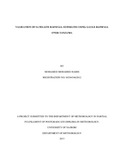| dc.description.abstract | This study sought to investigate the relationship between the gauge and satellite based rainfall
measurements over Tanzania based on gauge rainfall data spanning the period 1983 to 2012 from
the Tanzania Meteorological Agency while the corresponding satellite based rainfall estimates
were retrieved from the African Rainfall Climatology Project of the Climate Prediction Centre.
Data quality control, time series analysis (graphical and spectral), correlation and error analysis
techniques (Root Mean Square Error and Nash Sutcliffe coefficient) were used.
Graphical analysis indicated similar patterns of gauge and satellite estimates whose trend was
increasing over all stations. The periodogram indicated that rainfall records from satellite and
gauge stations were comparable with dominant period of approximately two years. Correlation
analysis showed that ground and satellite based rainfall over Tanzania were positively correlated
with the correlation coefficient ranging between 0.4 in Sumbawanga and 0.82 in Mtwara and
significant at 95% and 99% confidence level over coastal stations. The dominant frequency
indicated that rainfall patterns had a periodicity of two years over Tanzania. The RMSE showed
that satellite derived rainfall estimates positively deviated from the gauge rainfall while positive
values of the efficiency score showed that there was good skill except in Bukoba, Dodoma,
Mbeya, Mwanza, Pemba and Sumbawanga stations.
The study showed that satellite derived rainfall estimates from the African Rainfall Climatology
version 2 was comparable to gauge rainfall data. Implied that satellite derived rainfall estimates
could be used a great degree of skill in place of the gauge rainfall data. However, satellite
derived rainfall estimates were noted to overestimate gauge rainfall; the error analysis indicated
that these data sets were highly comparable as indicated by positive values in most of the
locations. Therefore, the study recommends that the National Meteorological and Hydrological
Centres (NMHS’s) to consider the use of satellite data in regions where the spatial network of
stations is highly sparse. | en_US |

